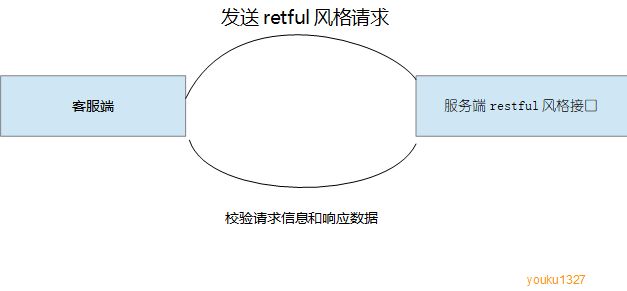springboot集成restTemplate实现rest接口调用
目录
一restTemplate简介
二restTemplate常用方法列表
2.1 get请求方法预览
2.2 post方法请求预览
2.3put请求方法预览
2.4 delete请求方法预览
2.5exchange方法预览
三rest接口调用示例
3.1 get请求接口调用示例
3.2 post请求示例
3.3 put接口调用示例
3.4delete请求示例
3.5 exchange
一restTemplate简介
restTemplate底层是基于HttpURLConnection实现的restful风格的接口调用,类似于webservice,rpc远程调用,但其工作模式更加轻量级,方便于rest请求之间的调用,完成数据之间的交互,在springCloud之中也有一席之地。大致调用过程如下图,如果想学习其底层具体如何实现可以查看我的文章 restTemplate源码详解深入剖析底层实现思路。
二restTemplate常用方法列表
forObeject跟forEntity有什么区别呢?主要的区别是forEntity的功能更加强大一些,其返回值是一个ResponseEntity,更加方便我们获得响应的body,head等信息。exchange方法和其他方法不同之处就是能自己定义的rest请求方式。
2.1 get请求方法预览
2.2 post方法请求预览
2.3put请求方法预览
2.4 delete请求方法预览
2.5exchange方法预览
三rest接口调用示例
restTemplate配置
首先本次示例采用的是springboot2.x以上版本,javaSE8;其次发布的服务端是同一台机子,服务端端口8090,客户端端口8080;类路径youku1327;在实际工作中最常用是get,post请求方式;restTemplate简单配置如下:
/**
* @Author lsc
* @Description
* @Date 2019/10/14 11:40
* @Version 1.0
*/
@Configuration
public class RestTemplateConfig {
// 配置 RestTemplate
@Bean
public RestTemplate restTemplate(ClientHttpRequestFactory factory){
return new RestTemplate(factory);
}
@Bean
public ClientHttpRequestFactory simpleClientHttpRequestFactory(){
// 创建一个 httpCilent 简单工厂
SimpleClientHttpRequestFactory factory = new SimpleClientHttpRequestFactory();
// 设置连接超时
factory.setConnectTimeout(15000);
// 设置读取超时
factory.setReadTimeout(5000);
return factory;
}
}
3.1 get请求接口调用示例
服务费发布的端口
@GetMapping("user")
public String getUser(){
return "youku1327";
}
@GetMapping("user/{name}")
public String getUserName(@PathVariable String name){
return name;
}
客户端调用
GET参数说明:
- 第一个参数是url。
- 第二个参数是返回值类型。
- 第三个参数是uri地址路径变量。
/*
* @Author lsc
* @Description 获得无参的get请求
* @Date 2019/10/17 21:15
* @Param []
* @return void
**/
@Test
public void testGETNoParams(){
String result = restTemplate.getForObject("http://localhost:8090/youku1327/user", String.class);
System.out.println(result);
}
/*
* @Author lsc
* @Description URL带参
* @Date 2019/10/18 13:49
* @Param []
* @return void
**/
@Test
public void testGETParams(){
// http://localhost:8090/youku1327/user/{1}
String result = restTemplate.getForObject("http://localhost:8090/youku1327/user/{name}", String.class,"lsc");
System.out.println(result);
}
3.2 post请求示例
POST请求参数说明
- 第一个参数是url。
- 第二个参数是请求参数。
- 第三个参数是返回值类型。
- 第三个参数是uri地址路径变量。
服务端发布接口
@PostMapping("provider")
public ResponseEntity addData(@RequestBody JSONObject jsonObject){
String user = (String) jsonObject.get("user");
return ResponseEntity.ok(user);
}
客户端接口调用
/*
* @Author lsc
* @Description post
* @Date 2019/10/18 23:23
* @Param []
* @return void
**/
@Test
public void testPostMethod() throws MalformedURLException {
JSONObject jsonObject = new JSONObject();
jsonObject.put("user","youku1327");
HttpHeaders httpHeaders = new HttpHeaders();
// 设置请求类型
httpHeaders.setContentType(MediaType.APPLICATION_JSON_UTF8);
// 封装参数和头信息
HttpEntity httpEntity = new HttpEntity(jsonObject,httpHeaders);
String url = "http://localhost:8090/youku1327/provider";
ResponseEntity mapResponseEntity = restTemplate.postForEntity(url, httpEntity, String.class);
System.out.println(mapResponseEntity.getBody());
}
3.3 put接口调用示例
PUT请求参数说明
- 第一个参数是url。
- 第二个参数是请求参数。
- 第三个参数是uri地址路径变量。
服务端发布接口
@PutMapping("provider/{id}")
public ResponseEntity updateData(@PathVariable Long id, @RequestBody JSONObject jsonObject){
Object object = jsonObject.get("user");
jsonObject.put("id",id);
// {"id":1327,"user":"youku1327"}
System.out.println(jsonObject);
return ResponseEntity.ok(jsonObject);
}
客户端接口调用
/*
* @Author lsc
* @Description put
* @Date 2019/10/18 23:23
* @Param
* @return
**/
@Test
public void testPutMethod() throws MalformedURLException {
JSONObject jsonObject = new JSONObject();
jsonObject.put("user","youku1327");
HttpHeaders httpHeaders = new HttpHeaders();
// 设置请求类型
httpHeaders.setContentType(MediaType.APPLICATION_JSON_UTF8);
// 封装参数和头信息
HttpEntity httpEntity = new HttpEntity(jsonObject,httpHeaders);
String url = "http://localhost:8090/youku1327/provider/{id}";
restTemplate.put(url, httpEntity, 1327);
}
3.4delete请求示例
DELETE请求参数说明
- 第一个参数是url
- 第二个参数uri地址路径变量。
服务端发布接口
@DeleteMapping("provider/{id}")
public ResponseEntity delData(@PathVariable Long id){
String result = "delete"+id+"success";
// delete1327success
System.out.println(result);
return ResponseEntity.ok(result);
}
客户端调用接口
/*
* @Author lsc
* @Description delete
* @Date 2019/10/18 23:22
* @Param []
* @return void
**/
@Test
public void testDelete(){
String url = "http://localhost:8090/youku1327/provider/{id}";
restTemplate.delete(url,1327);
}
3.5 exchange
参数说明:
- 第一个参数是url。
- 第二个参数是请求方式。
- 第三个参数是请求实体。
- 第四个参数是返回值类型。
- 第五个参数是uri地址变量。
服务端发布接口
@GetMapping("user/{name}")
public String getUserName(@PathVariable String name){
return name;
}
客户端调用接口
/*
* @Author lsc
* @Description exchange
* @Date 2019/10/18 23:22
* @Param []
* @return void
**/
@Test
public void testExchange(){
String url = "http://localhost:8090/youku1327/user/{name}";
HttpHeaders httpHeaders = new HttpHeaders();
httpHeaders.setContentType(MediaType.APPLICATION_FORM_URLENCODED);
HttpEntity httpEntity = new HttpEntity(httpHeaders);
ResponseEntity exchange = restTemplate.exchange(url, HttpMethod.GET, httpEntity, String.class, "youku1327");
System.out.println(exchange.getBody());
}




